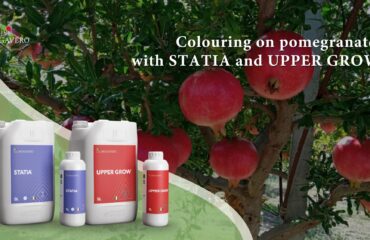
Statia. This is the name of the innovative plant created by Mugavero to protect both tomato as such and its cultivation. Aspects, often, too underestimated. Readily assimilable and completely soluble, Statia represents the perfect solution for all the needs of the farmer, in particular for maintaining the vigour of the plant to maintain the production yield per unit of constant surface. Considering that the summer transplants of tomatoes in a protected environment often problems of “spinning”. In other words, the plant, in the presence of high thermal values, tends to lengthen the internodes between one production stage and the next.
Statia and the tomato
 Applicable regularly throughout the vegetative-productive cycle, Statia contributes to solving some main problems caused by “branching” products, such as residuality and imbalance induced on the plant, and allows to keep the plant healthy and contain the number of active ingredients used. in defence strategies. Furthermore, since the product has excellent miscibility, at the doses indicated on the label, with the foliar fertilizers and pesticides on the market, the Statia solution by Mugavero allows the thickening of the leaf plate in the periods in which the root of the plant, due to the low values thermal, not assimilable correctly.
Applicable regularly throughout the vegetative-productive cycle, Statia contributes to solving some main problems caused by “branching” products, such as residuality and imbalance induced on the plant, and allows to keep the plant healthy and contain the number of active ingredients used. in defence strategies. Furthermore, since the product has excellent miscibility, at the doses indicated on the label, with the foliar fertilizers and pesticides on the market, the Statia solution by Mugavero allows the thickening of the leaf plate in the periods in which the root of the plant, due to the low values thermal, not assimilable correctly.
Consequently, there is no doubt that its foliar application represents valid support to fertigation in the phenological phases in which there are high requirements for phosphorus and potassium. But that is not all. Since in the phase of tomato cultivation in a protected environment one of the fundamental aspects to be protected – even if often neglected – is the need to disinfect the cuts, green pruning and contain fungal infections, Statia allows the fast healing of plant tissues. As a function of the applied dose, it contains the vegetative vigour by shifting the sink-source equilibrium towards production. Close to veraison, it promotes the synthesis of sugars and the degradation of acids in the very early stages.
If this article on tomato was helpful to you, keep following us on our blog and our social channels: Facebook, Instagram, LinkedIn, YouTube

 Italiano
Italiano  English
English  Español
Español  Türkçe
Türkçe  Русский
Русский  العربية
العربية  Français
Français 


